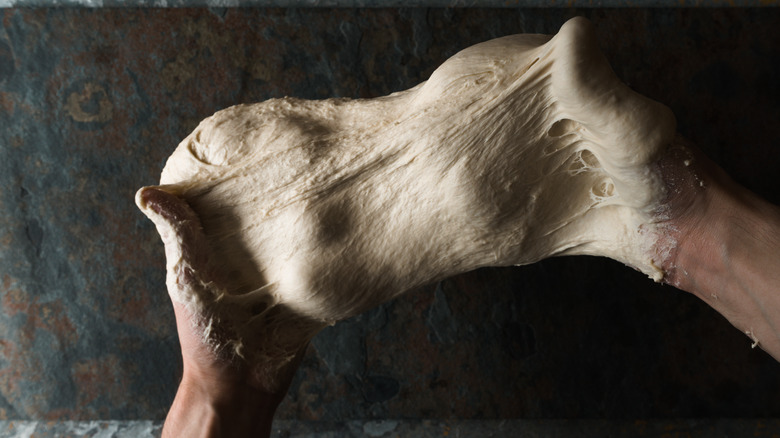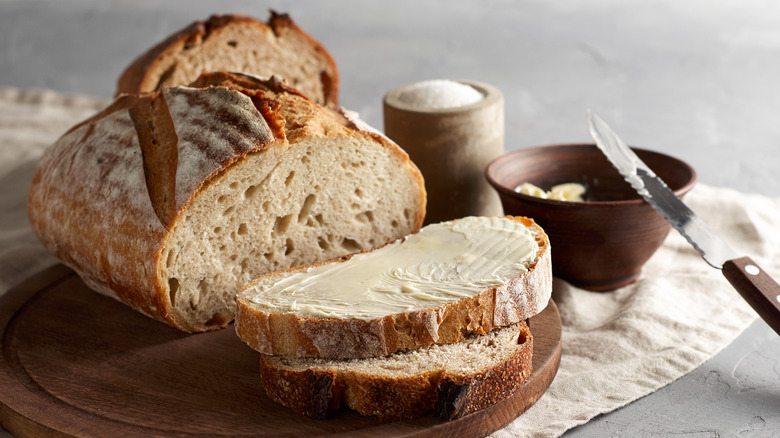Paul Hollywood's Genius Trick For Rolling Dough Without Sticky Hands
The world's seen something of a baking renaissance in the past few years. According to a 2020 CNBC article, posts with the hashtags #stressbaking and #quarantinebaking reached the tens of thousands, with people self-soothing with sweet treats and sourdough bread during the lockdown. Home cooking crazes and supply chain shortages drove ingredient prices up, per NPR, but that didn't stop people trying to dodge COVID-19 and curb cabin fever by filling their homes with delicious oven aromas and their bellies with baked goods.
If you're a baker, including one of the many people who started baking bread during the pandemic, you've probably encountered what Paul Hollywood calls "sticky hand syndrome." It's a disheartening experience, especially since baking calls for precision, patience, and a lot of hands-on labor. The not-so-secret ingredient to stellar homemade bread is elbow grease, but all too often, the dough clings to bakers' hands during the long and arduous kneading process. Hollywood's hack will help — and doesn't require a mess of flour everywhere.
You knead to know this trick
Paul Hollywood explains that when you're kneading dough, you can put oil on your work surface instead of flour. The baker and TV personality says it won't change the texture of the dough and will reduce the so-called sticky hand syndrome. Then you can knead your bread efficiently, one of the many crucial steps in achieving a perfect loaf. Cook's Illustrated suggests using vegetable oil, but you can simply use the oil you've already put in the dough, whether it's canola, olive, avocado, or even coconut oil.
Flouring your hands and the tabletop can help here too, but given how many things can go wrong while baking, why further complicate things? Busby's Bakery warns that when you dust your table or countertop, it introduces raw flour into the developing dough, resulting in paltry gluten bonds, an undesirable crumb, off flavors, and an unfortunate color in your finished bread. They only recommend using flour if the dough is especially tacky and gluey. The dough takes in oil without a fuss. Plus, let's face it, if you're working on unfinished wood, it probably needs a little oil anyway.
No-dread bread
Busby's Bakery shares, via Peter Reinhart's "Bakers Bible," that the above method is called an "oil slick," and it entails applying one tablespoon of oil to your workspace and rubbing it around with your hands. Butter or lard will also work here. Contrary to the name, they explain that you're after a light coating, not a pool — but you can dab up extra oil with paper towels and use it to grease pans. They recommend using a degreaser or good dish soap to clean your hands afterward and remind bakers to keep in mind that it may stain wooden surfaces.
Now that you'll have one less setback to worry about for your next baking project, why not broaden your bready horizons? Paul Hollywood's white bread is a good jumping-off point — perfect for spreads and toast. As many newfangled bakers will attest, you'll never go back to the store-bought stuff. There's also his classic cottage loaf, as seen on "The Great British Bake Off," a traditional style rustic bread Hollywood enjoys with soup and as sandwiches. A stunning focaccia is a great idea, and you can even try decorating it like art (per Farmer's Almanac) or turn it into a delicious Provençal pizza. You're safe from sticky hands syndrome, so get those hands into some dough!


